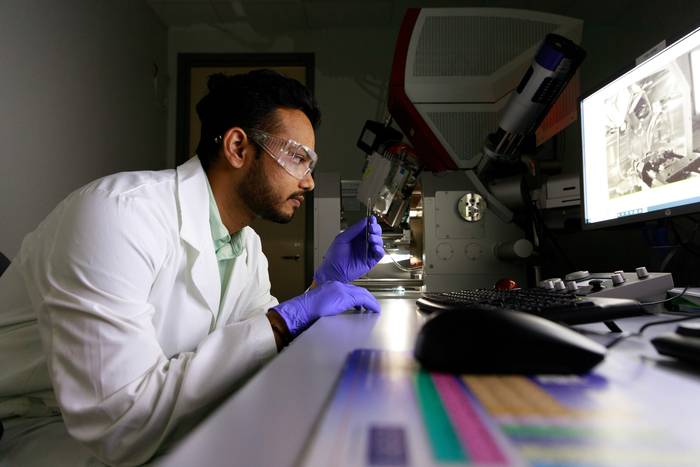Reviewed by Alex SmithSep 8 2021
Ceramics can withstand high heat and extreme environments. However, they tend to be delicate and break easily. In a new study, researchers from Texas A&M University have recently found a self-healing mechanism within a kind of ceramics known as MAX phases.
 Hemant Rathod observes a sample of chromium aluminum carbide before loading it into the scanning electron microscope. Image Credit: Dharmesh Patel/Texas A&M Engineering.
Hemant Rathod observes a sample of chromium aluminum carbide before loading it into the scanning electron microscope. Image Credit: Dharmesh Patel/Texas A&M Engineering.
The study has been published in the Science Advances journal.
The researchers have revealed that these engineered ceramics tend to develop natural faults or kink bands while loading that not just effectively stop crack formation but also close and heal them, thereby avoiding catastrophic failure.
What’s really exciting about MAX phases is that they readily form kink-bands under loading which can self-heal cracks even at room temperature, making them suitable for a variety of advanced structural applications.
Dr. Ankit Srivastava, Study Corresponding Author and Assistant Professor, Department of Materials Science and Engineering, Texas A&M University
“So far, self-healing of cracks in ceramics has only been achieved at very high-temperatures by oxidation and that is why self-healing of cracks at room-temperature by kink-band formation is remarkable,” added Srivastava.
MAX phases exhibit exceptional behavior thanks to their atomically layered structures.
Imagine a plain loaf of bread, it is homogeneous, so if I slice it up, each slice will look the same—similar in idea to conventional ceramics. But MAX phases are layered like a peanut butter sandwich with peanut butter between two slices of bread.
Dr. Miladin Radovic, Study Corresponding Author and Professor, Department of Materials Science and Engineering, Texas A&M University
Then, the scientists examined whether this special layered structure of MAX phases makes them any different from traditional ceramics. They used single-crystal samples made of chromium aluminum carbide MAX phase for the experiments.
The samples were synthesized by Dr. Thierry Ouisse of Université Grenoble Alpes, France, and a senior author on the study. The samples were loaded within an electron microscope using an in-house designed test fixture.
The observation of the deforming sample in the electron microscope while loading revealed that there were kink-band-like defects that developed in the material, similar to those formed in natural rocks.
More fascinatingly, they found that the material inside kink-bands rotate at the time of loading, which not only develops a barrier against crack propagation but also closes and heals the cracks. As a result, the sample was no longer susceptible to catastrophic failure.
What’s really exciting is that this kinking or self-healing mechanism can occur over and over closing the newly formed cracks, thus delaying the failure of the material.
Hemant Rathod, Study Lead Author and Doctoral Student, Department of Materials Science and Engineering, Texas A&M University
This breakthrough, demonstrating that materials like MAX phases are resilient to heat and extreme environments, and also exhibit the potential to self-heal cracks that might develop during service, can lead to the development of a wide range of next-generation technologies, for example, safer nuclear reactors, hypersonic flights and efficient jet engines.
In this study, the researchers observed that the kink-band caused the self-healing of cracks that are most likely not exclusive to MAX phases and applied to other materials with similar atomically layered structures.
“This study demonstrates the serendipity of the scientific process. We have had self-healing soft materials and polymer composites, and now, remarkably, ceramics,” stated Siddiq Qidwai, a program director in the National Science Foundation’s Directorate for Engineering.
This study was financially supported by the National Science Foundation.
Journal Reference:
Rathod, H. J., et al. (2021) Room temperature crack-healing in an atomically layered ternary carbide. Science Advances. doi.org/10.1126/sciadv.abg2549.